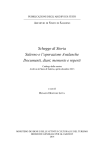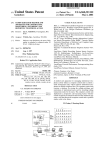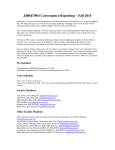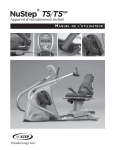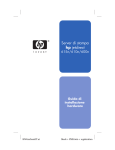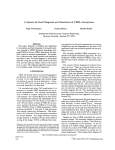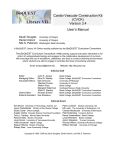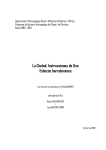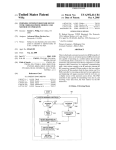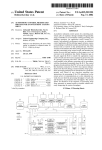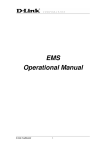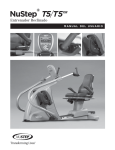Download Computer-based method and apparatus for controlling, monitoring
Transcript
US006920209B1 (12) United States Patent (10) Patent N0.: (45) Date of Patent: Gainsboro (54) COMPUTER-BASED METHOD AND APPARATUS FOR CONTROLLING, MONITORING, RECORDING AND Bahl, L. “A Maximum Likelihood Approach to Continuous Speech Recovery”, Readings in Speech Recognition Ed. A. Waibel and K. Lee, Morgan Kaufmann Publishers, pp 308—319, IEEE 1983. (75) Inventor: Jay L. Gainsboro, Framingham, MA Batten, A. “Personal Communications Service and the Intel (Us) ligent Network”, British Telecommunications Engineering, vol. 9, pp 85—91 Aug. 1990. (73) Assignee: T-NetiX, Inc., Carrollton, TX (US) Notice: Jul. 19,2005 OTHER PUBLICATIONS REPORTING TELEPHONE ACCESS (*) US 6,920,209 B1 Lee, K. “Large—Vocabulary Speaker—Independent Continu ous Speech Recognition Using HMM”, Carnegie Mellon University Department of Electrical and Computer Engi neering, CMU—CS—88—148 Apr. 1988. System 20, Nov. 1992. Subject to any disclaimer, the term of this patent is extended or adjusted under 35 U.S.C. 154(b) by 136 days. (21) Appl. N0.: 10/327,248 Telematic “ConQuest III Intimate Telephone System” Nov. (22) Filed: LaZerVoice, Digital Recording System Inmate Services, 1992. Dec. 19, 2002 1997—98 Schlumberger Technologies, Inc./LaZerVoice , STIL V0222 LaZerVoice User’s Manual—Version 2.22. LaZerPhone User Reference Manual. Related US. Application Data (63) LaZerPhone, Inmate Telephone System, Users Manual, 1998 Schlumberger Technologies, Inc./Global Tel*Link, LaZer Continuation of application No. 08/904,784, ?led on Aug. 1, 1997, now Pat. No. 6,560,323, which is a continuation of application No. 08/510,327, ?led on Aug. 2, 1995, now Pat. No. 5,655,013, which is a continuation of application No. 08/229,517, ?led on Apr. 19, 1994, now abandoned. (51) Phone User’s Manual—Version 1.0. LaZerPhone, Powerful Performance Uncompromising Stan dards, 1998. LaZerPhone Technical Manual, System Overview. Int. Cl.7 ............................................... .. H04M 3/00 (52) .. 379/188; 379/199; 379/249 (58) Field of Search ......................... .. 379/91.01, 91.62, Primary Examiner—Roland G. Foster (74) Attorney, Agent, or Firm—Fenwick & West LLP 379/112, 143, 144, 145, 101, 108, 189, 196, 198, 199, 200, 34, 35, 207.01, 207.02, 207.11, 211.01, 211.02, 216.02, 211.03, 114.01, 114.41, 112.01, 144.01, 85.16, (57) A method and apparatus for managing institutional tele 188, 249 (56) phone activity utiliZes a computer control unit to control a trunk management unit, which connects institutional tele References Cited phones to outside telephone lines. The computer control unit contains a database for storing the calling privileges and restrictions of institutional users and for recording calling U.S. PATENT DOCUMENTS 3,851,121 A 4,001,513 A 4,002,848 4,054,756 4,188,508 4,310,726 4,405,833 A A A A A 11/1974 Marvin transactions made by the users. The computer control unit 1/1977 Naylor 1/1977 10/1977 2/1980 1/1982 9/1983 ABSTRACT implements a prospective call screening feature whereby Stein Comella et al. Rogers et al. Asmuth Cave et al. outside recipients of undesired calls from the institution may enter a code that directs the computer control unit to prohibit similar calls in the future. 15 Claims, 5 Drawing Sheets (Continued) EQUIPMENT LOCATED IN TELEPHONE ROOM INNAIE IELEPHDNES INHAIE TELEPNUNES US 6,920,209 B1 Page2 US. PATENT DOCUMENTS 4,518,825 4,559,416 4,602,129 4,696,031 4,726,057 4,782,516 4,794,642 4,799,255 4,815,120 4,885,765 4,896,348 4,899,375 4,901,341 4,922,519 4,922,520 4,924,488 4,933,966 4,933,967 4,935,956 4,937,862 4,993,068 5,023,869 5,023,906 5,033,088 5,054,059 5,063,593 5,109,405 5,131,024 5,150,357 5,163,083 5,187,740 5,200,995 5,210,789 5,222,120 5,229,764 5,274,698 5,276,731 5,305,312 5,309,505 5,311,589 5,319,702 5/1985 12/1985 7/1986 9/1987 2/1988 11/1988 12/1988 1/1989 3/1989 12/1989 1/1990 2/1990 2/1990 5/1990 5/1990 5/1990 6/1990 6/1990 6/1990 6/1990 2/1991 6/1991 6/1991 7/1991 10/1991 11/1991 4/1992 7/1992 9/1992 11/1992 2/1993 4/1993 5/1993 6/1993 7/1993 12/1993 1/1994 4/1994 5/1994 5/1994 6/1994 Brikerhoff et al. Theis et al. Matthews et al. Freudberg et al. Doerry et al. Maybach et al. ArbabZadah et al. Billinger et al. Kosich et al. Shirakawa Grantland et al. Bauer et al. Carter et al. Daudelin Bernard et al. Kosich Hird et al. Lo et al. HellWarth et al. Kosich Poisenka et al. Grover et al. Novas Shipman Stern et al. Kwon Morganstein Pugh et al. Hopner et al. Dowden et al. SWaim et al. Gaukel et al. Jeffus et al. McLeod et al. Matchett et al. Jang Arbel et al. Fornek et al. SZlam et al. Bennett et al. Kitchin et al. 5,325,427 5,327,489 5,329,578 5,345,595 5,351,287 5,355,403 5,375,161 5,442,696 5,452,347 5,465,293 5,471,519 5,483,582 5,483,593 5,535,261 5,539,812 5,566,229 5,583,934 5,606,604 5,617,471 5,627,887 5,651,056 5,655,013 5,722,418 5,724,404 5,745,553 5,796,811 5,799,068 5,805,685 5,809,125 5,844,978 5,883,945 5,926,533 5,943,403 5,960,064 6,052,454 6,072,860 6,141,406 RE37,073 6,188,751 6,560,323 6,611,583 E 6/1994 7/1994 7/1994 9/1994 9/1994 10/1994 12/1994 8/1995 9/1995 11/1995 11/1995 1/1996 1/1996 7/1996 7/1996 10/1996 12/1996 2/1997 4/1997 5/1997 7/1997 8/1997 3/1998 3/1998 4/1998 8/1998 8/1998 9/1998 9/1998 12/1998 3/1999 7/1999 8/1999 9/1999 4/2000 6/2000 10/2000 2/2001 2/2001 5/2003 8/2003 Dighe Anderson et al. Brennan et al. Johnson et al. Bhattacharyya et al. Richardson, Jr. et al. Fuller et al. Lindberg et al. Iglehart et al. Chiller et al. Howe et al. Pugh et al. Gupta et al. Brown et al. Kitchin et al. Hou et al. Zhou Rosenblatt Rogers et al. Freedman Eting et al. Gainsboro Bro Garcia et al. Mirville et al. McFarlen Kikinis et al. McFarlen Gammino Reuss et al. Richardson et al. Gainsboro Richardson, Jr. et al. Foladare et al. Kek et al. Kek et al. Johnson Hammond Scherer Gainsboro Gainsboro U.S. Patent Jul. 19,2005 Sheet 1 0f 5 _ n u w MW MN Wm % %ANw“nu.“" zs?oéz$325 _\| Mm "$2252 2%% MW Mw U _ l12H6Q\wE}.; ,120% x 1, é n, w % @ MW _l . 582915 m “MN MN. W. W MW nw Mwuz?waés " n _ , . _ n ‘(?aw zmz??_Ea: a _ 1I|. 25%. US 6,920,209 B1 U.S. Patent Jul. 19, 2005 OT sow“ THU F IRMWARE Sheet 2 0f 5 SOL MENU S01. FORMS ORACLE INTERFACE *éQQLTTFQOMLE 'ORACLE DBMS UNIX OPERATING SYSTEM F/G.2 US 6,920,209 B1 50L REPORT WRITER U.S. Patent Jul. 19, 2005 Sheet 5 of5 US 6,920,209 B1 TRUNK MANAGEMENT UNIT ATE DESTTNATION ALERT NUMBER XJANXX (XXXTXXXXXXX |NMATE(CALLERTGOES OFF ENFORCER°SYSTEM PERFORMS ITS HOOK AND ENTERS DIGITS STANDARD INMATE AccouIIT REPRESENTING A PRE-APPROVED DESTINATION PARAMETER cIIEcIIs AND IF VALIDATED coIIREcTS CALL TO PHONE NUMBER a PIN PRE- APPROVED ‘DESTINATION PARTY THE lGlT ARETRRIIsIIITTEn" jzlvm RoII LINES AND RECEIVED‘ (IF CA U I sroRw AR OED)‘ IBWYHEUE 0SRYCSETREIISAISIITERRREITEMs,l lTRIE DIGITS AS AN ACTION m» I |1)|DENTIFY THE oRIcImL l APPROVED PHONE NUMBERIN ‘ 0 DES T INATT oN PARTY FRWARDS ' DESTINATION PARTHAT CALLING 0R CONFERENCE REEEMEUCUER! WWW I THAT PHONE NUMBER WHICH 1 THE CALL usIIIc S-WAY PR -AP 0 PH CALLING To ANOTHER I TINTCANMTAETEEAEECNNUTIAUE I ) lzIAssIcII AN ALERT CODE To 55 I THE SYSTEM IIIL DESTINATION NUMBER RECOGNIZE AS me A I I PHONE NUMBER IIIIIcR- | IT’TEHETBTNIHMTW II I THE INHATE ISBLOCKEDFROM I MAKING FURTHER CALL I ATTEMPTS I THE PARTY DETERMINES THAT THEY 00 NOT WANT To BE CAUID I BI THAT PIN NUMBER AGAIN, T NEW PARTY RECEIVES CALL AND DETERNTNES THAT THEY WANT TO THE PARTY ENTER GOT U OIOIT CODE INTO TELEPHONE KEY PAD, THEN HANGS UP TTDISOONTINUE THE CURRENT L CALL. AND/OR 2T PREVENT CALLER FROM CALUNG THEM AGAIN , TAKEN BY A CALLED I_ _ __ _ __ _ __ _ _| 5 US 6,920,209 B1 1 2 COMPUTER-BASED METHOD AND environment, it does not Work Well in a penal institution. The reason is that inmates shoW little concern for phone bills they can’t afford to pay. Thus, the institution is often forced APPARATUS FOR CONTROLLING, MONITORING, RECORDING AND to absorb the costs of phone calls by its delinquent inmates. Moreover, the fact that account balances are only computed periodically—i.e., every month, Week, or even every day— permits the inmate to accrue large, uncollectible phone bills REPORTING TELEPHONE ACCESS CROSS-REFERENCE TO RELATED APPLICATIONS before his access to the phones can be terminated. This application is a continuation of application Ser. No. 08/904,784, entitled “Computer-Based Method and Appa ratus for Controlling, Monitoring, Recording and Reporting Telephone Access,” ?led Aug. 1, 1997 now US. Pat. No. 6,560,323, Which is a continuation of application Ser. No. 08/510,327, ?led Aug. 2, 1995, Which Was issued as US. Pat. No. 5,655,013, Which is a continuation of application Ser. No. 08/229,517, ?led Apr. 19, 1994, Which Was aban doned. The above applications are incorporated by reference 10 15 in their entirety. 20 Another problem in penal institutions is the inmates’ desire to make threatening or harassing phone calls to Witnesses, prosecutors, police officers, parole of?cers, telecommunications and penal institution management. psychologists, judges, and the relatives and family of such More particularly, the invention relates to a computer-based method and apparatus for controlling, monitoring, recording and reporting access to outside telephone lines in a controlled, institutional environment, such as a prison, mili still provides the inmates With relatively unlimited access to the outside World, leaving open numerous opportunities for fraudulent and criminal activity, as explained beloW. Therefore, in a penal environment, it is highly desirable to regulate phone access on an individual, pay-in-advance basis, and to immediately and automatically terminate an individual’s phone access When his/her paid-up account reaches a Zero balance. FIELD OF THE INVENTION The present invention relates generally to the ?elds of Traditionally, penal institutions have addressed this problem by restricting inmates to collect calls only. This, hoWever, 25 tary base, hospital, school, business or government organi persons. Limiting the inmates’ access to collect calls only does not effectively address this problem, since an inmate can easily identify himself (to an operator) as someone from Whom the recipient Would likely accept a collect call. Rather, one should, at a minimum, provide a means that Zation. permits a potential call recipient to identify the caller as an inmate before accepting the call, Whether that call is placed BACKGROUND OF THE INVENTION Generally, the need to control access to outside telephone lines in an institutional environment is Well recogniZed. In order to prevent individuals from incurring large, unac 30 countable telephone costs Which the institution ultimately bears, one must either restrict access to outside telephone 35 lines or institute accounting controls Whereby the costs of unauthoriZed calls can be billed to the responsible individu als. placed from a correctional facility and that, if the recipient Wishes not to receive the call, he/she should hang up before the call is connected. This approach mitigates, but does not fully solve, the harassment problem. In particular, it is still possible for an inmate to repetitively call an outside party; even if the recipient hangs up after hearing the pre-recorded message, the harassing effect of receiving repetitive calls Telephone systems in correctional environments require additional security considerations. Without appropriate con on a prepaid or collect basis. Conventionally, this is done by initially placing the inmate on hold and playing a pre recorded message telling the recipient that a call has been trols on telephone access, inmates have been knoWn to use from inside the correctional institution remains. Therefore, it Would be highly desirable to provide an institutional tele the telephones to harass outside parties (such as Witnesses phone system that automatically prohibits inmates from Who testi?ed against them, attorneys Who prosecuted their case, employees of the courts, etc.), to perpetrate fraudulent schemes, and to participate in criminal conspiracies (such as arranging the smuggling of contraband into the prison, directing an outside criminal enterprise, plotting escape attempts or credit card fraud). Therefore, it is critically important for correctional management officials to carefully attempting to call certain outside persons. Moreover, it Would also be highly desirable to provide a method and apparatus for alloWing a recipient of an undesired call from an inmate to easily and automatically prohibit all future calls from that particular inmate, or from all inmates generally. 40 45 Still another concern in correctional institutions is the regulation of access to telephone systems. For various security and management reasons, it often desirable to restrict a given inmate’s telephone access to particular plan, control, monitor and record inmate access to outside telephone lines. One of the most fundamental problems—Which eXists both in correctional and other business-oriented institutions—is cost control. To achieve cost control, it is critical that there be individual accountability for each call that incurs a charge to the institution. Such accountability is phones, calling times, and to limit the length of calls, number of calls, and number of calls to the same number. 55 Also, to enhance security and discipline, it should be pos sible to instantaneously revoke an inmate’s calling privileges, or to otherWise modify the eXtent of a particular typically achieved through use of personal identi?cation inmate’s calling privileges. numbers (“pins”). Before making a call from an institution telephone, an individual must enter his PIN. The telephone service provider is then able to deliver to the institution an end-of-the-month telephone bill Which lists, in addition to and/or record outgoing calls. Inmate-to-attorney calls, Correctional institutions also typically Wish to monitor 60 Moreover, certain inmates—those Who represent particular the cost of each call, the PIN or name of the individual Who made the call. From this information, the institution can then collect reimbursement from individuals for the costs of certain calls. While this system of end-of-the-month call accounting functions reasonably effectively in a business like hoWever, cannot legally be monitored or recorded. security risks—deserve live monitoring, as opposed to mere recording. Thus, it Would be highly desirable to have a 65 system Which automatically initiates the appropriate moni toring and/or recording depending upon the identity of the inmate placing a call and the recipient of the call (i.e., attorney or non-attorney). LikeWise, it may be desirable that US 6,920,209 B1 3 4 calls to certain numbers are to be monitored live, While institutional caller or, if desired, prohibiting calls from any person Within the institution and/or related institutions. others need only be recorded. Because the message content of inmate-to-attorney calls cannot be legally recorded or monitored, such calls can serve Alternatively, if voice prompting or voice menus are not available or not desired, then the public-at-large can be as a conduit for the inmate’s illegal telephone activity. Therefore, it Would be highly desirable to have a system Which could passively—that is, Without in any Way moni upon receipt of undesired calls from such institutions, the informed that the “GOTU” feature is available in their area, and With respect to certain institutions in their area, and then, called party can enter the “GOTU” touchtone or keypad toring or recording What is actually being said—monitor inmate-to-attorney calls to ensure that: (1) the only tWo people speaking on the line are the inmate and attorney, 10 and/or (2) no DTMF tones, rapid line impedance changes, off-hook conditions or voltage spikes appear on the line. Techniques for voice identi?cation are knoWn—i.e. US. Pat. No. 4,993,068, entitled UNFORGEABLE PERSONAL IDENTIFICATION SYSTEM and US. Pat. No. 5,150,357, entitled INTEGRATED COMMUNICATIONS SYSTEM, called party’s telephone number, blocking during particular 15 previously used in penal telecommunications applications. SUMMARY OF THE INVENTION In light of the above, one object of the invention is a method of managing telephone activity in an institutional environment to achieve improved security and reduced cost. Another object of the invention is a system adapted to 25 Still another object of the invention is a method and apparatus for alloWing outside recipients of calls from an institution to decide, in advance of connecting the call, Whether to accept the given call and Whether to block calls the inmate, or that the number called by the inmate can not be reached for any number of reasons, as established by the call—plays an announcement to the called party identifying the institution and caller, along With the options available to the called party. In response, the called party may enter the announced DTMF tone sequence (preferably GOTU), Which modi?es a record in the database, thereby prohibiting the 35 prison administration, or the actual party called by the inmate. Yet another object of the invention is a method and apparatus for passively monitoring a telephone connection 40 to detect security breaches. A still further object of the invention is an institutional telephone management system Wherein the parameters that control the operation of the system as Well as the records of includes: a plurality of institutional telephones located Within the institution; a trunk management unit (TMU) for selectively connecting the institutional telephones to one or more outside telephone lines, Wherein the TMU includes means for decoding DTMF tones generated by the institu tional telephones or received from the outside telephone lines; and a computer control unit (CCU), coupled to the TMU, for controlling the connection of the institutional telephones to the outside telephone lines based upon DTMF tone(s) received from the outside telephone lines. Adatabase associated With the CCU contains information regarding the calling privileges of each person Within the institution. In a preferred embodiment, the TMU—prior to connecting the from that person and/or others Within the institution or related institutions in the future, and optionally, Whether to indicate to the inmate that the call has been either tempo rarily or permanently blocked by a particular party, includ ing the prison administration, or the actual party called by time periods, blocking based on the class of the crime associated With a particular inmate, etc. In accordance With another aspect of the invention, an apparatus for managing telephone activity in an institution both incorporated herein by reference—but have not been perform such improved institutional telephone management. sequence. Any multitude of call prohibitions can be estab lished as to any particular inmate by the prison administra tion or the called party, including total blocking based on the 45 system activity are stored in a central database, thereby caller (and/or other similarly situated prospective callers) from calling the called party in the future. Other features of the TMU provide security and monitor ing functions. The invention provides three levels of monitoring, any or all of Which may be active for any given call. The ?rst level is “live” call (voice) monitoring, Where the prison of?cials actively listen to a live call. The second level is call recording. The TMU can be programmed to enable associated recording equipment to record telephone calls. The third level is “passive” line monitoring, Where the TMU detects, for example, DTMF tones, off-hook conditions, voltage spikes and/or sudden line impedance permitting simple customiZation of system operation, gen changes, in order to thWart attempts at unauthoriZed three eration of reports and monitoring of status. Way calling, call conferencing, call transferring, call for In accordance With one aspect of the invention, a method Warding or re-dialing via various alternate common carriers, of managing telephone activity in an institution includes the many of Whom noW offer “1-800” or local telephone number steps of: (1) identifying an institutional caller (the “calling (e.g., “950”) access numbers. Also, care is taken to avoid party”) Who Wishes to place an outside call to an outside disrupting calls that do not represent security breaches, by preventing false triggering of the above “passive” line monitoring features. For eXample, With respect to DTMF recipient (the “called party”); (2) blocking the institutional caller and—While the institutional caller’s line (earpiece and/or mouthpiece) remains blocked—(a) calling said out 55 tone blocking, the TMU Will look for any additional digits side recipient (called party), (b) providing the identity of entered by an institutional caller, such as an inmate, to said institutional caller to said outside recipient and (c) receiving a control code from said outside recipient; and (3) determining, in response to said control code, Whether to prevent the inmate from redialing to other telephone num bers that may not be authoriZed. HoWever, to prevent “talkoff”, Whereby the normal telephone conversation can falsely trigger a disconnect signal (because the TMU may connect the institutional caller to the outside recipient, and optionally, Whether to indicate any of a plurality of messages to the calling party, e.g., an inmate. The control code interpret the conversation as DTMF dialing), the TMU can be set to look at the number of digits dialed Within a speci?ed time period (e.g., siX (6) digits Within a ?fteen (15) preferably comprises a series of DTMF tones, for eXample the sequence 4688, Which spells the pneumonic “GOTU”. In response to the recognition of a control code, the outside recipient is provided With the option (via a voice prompt menu) of prohibiting any future calls from the particular 65 second time period, or any variation of the tWo parameters) and thereby, determine Whether the audio information is indicative of unauthoriZed DTMF redialing or just a normal speech or voice pattern. US 6,920,209 B1 5 6 In accordance With the preferred embodiment of the invention, all calls are passively monitored and all calls that can be legally recorded—i.e., all but inmate-to-attorney calls—are recorded. At any time, prison officials can selec tively invoke live monitoring to listen in on any call in progress, except an inmate-to-attorney call. System alarms, Which trigger any time a particular inmate places a call or should not be vieWed as limiting, since the invention is also applicable in other institutional settings such as military bases, schools, mental institutions and business organiZa tions. Referring noW to FIG. 1, a call management system manages calls from a plurality of inmate telephones 1. A TMU 2 controls the connection of individual inmate tele calls a certain person, alloW officials to determine When live phones (for example 1a) to outside telephone lines 8, and call monitoring is appropriate. Likewise, the telephone sys electronically monitors connected calls. A TMU 2 can tem of the present. invention can be programmed to default in any manner. For example, the system can be set to place only those telephone calls that are among a preapproved list of telephone numbers. Conversely, the system can be set to place all telephone calls except those that are among a list of optionally contain (and/or be connected to external) voice messaging or voice synthesis equipment, to facilitate fea tures such as over-the-phone voice prompting, voice mail, or any voice activated, responsive or interactive telephone restricted telephone numbers. Optionally, the telephone sys tem of the present invention can include speed-dialing, Whereby upon entering a PIN, for example, an inmate can enter “11” folloWed by the “#” key. In that case, the prison administrator may have established that “11” is the speed dialing sequence for that inmate’s mother. Of course, the system could be con?gured so that the inmates themselves 15 Additionally, the inmate could ascertain hoW much any prior telephone call has cost, and further, could dial an intended telephone call, and ascertain hoW much that call Will cost for the ?rst time period (e.g., the ?rst minute), or, ?nd out hoW can program the telephone system With speed-dialing digits, hoWever, a principal objective of speed-dialing is to save time at the telephone, thus making the telephones available to the largest number of inmates in the shortest possible time period. many minutes the inmate can be connected to that telephone 25 In addition, the invention may include biometric voice veri?cation features. The TMU, for example, may digitiZe a sample of the caller’s voice. The CCU then compares the digitiZed sample With a stored voice print, to verify the identity of the caller. Such biometric monitoring may also be used in a passive call monitoring mode, Wherein periodic samples of the caller’s voice are provided to the CCU—and during a call connection, inmate funds become nearly exhausted, a Warning tone could inform the inmate of that condition, so that the inmate can terminate the conversation, and take appropriate steps to replenish his/her account. Such that no unauthoriZed callers are participating in a call, and to ensure that inmates are not sharing or selling relatively 35 inmate account to other inmates that are subject to more Warning tones could be made possible by a real time call cost monitoring system, that compares inmate call costs and inmate account balances While each call is in progress. A serial interface card 4 digitally interfaces TMU 2 to: a CCU 3, one or more administrative terminals 5a—b and, via data modems 6a—b, to a remote terminal 7. Of course, limited calling privileges. The use of biometric voice veri ?cation (or “voice prints”) can prevent PIN abuse in general. For example, if a particular inmate With restricted calling privileges, or no available funds, attempted to force (e.g., by number, given the cost of that call and the amount remaining in the inmate’s account, all prior to actually completing the call and becoming obligated to pay for it. Obviously, for debit-based systems, inmate calls Will not be placed in the event that suf?cient funds are not available. Further, if checked against a list of authoriZed voice prints—to ensure liberal calling privileges associated With a particular PIN or feature. For example, an inmate could enter his/her PIN into a telephone 1 keypad, and then, access his/her account. In turn, voice equipment associated With or contained Within the TMU could inform the inmate of the exact balance available in his/her account for future telephone calls. 40 remote terminals 7, administrative terminals 5 and CCUs 3 can be connected via so-called dedicated data/telephone line threatening physical attack) another inmate With relatively non-restricted calling privileges (or available funds) to turn services, obviating the need for actual modems 6. TMU 2 communicates bi-directionally With CCU 3. In over his PIN, biometric voice veri?cation Would obviate this problem, as the voice Would be used to validate entry into one direction, CCU 3 directs TMU 2 to connect, record, passively monitor and terminate calls, and to doWnload any inmate account. 45 BRIEF DESCRIPTION OF THE DRAWINGS real-time status—i.e. off-hook, DTMF tones, voltage spikes and rapid impedance changes—of institutional and outside telephone lines. In addition, TMU 2 can provide digitiZed The detailed description beloW describes the preferred embodiments of the invention and is intended to be read in conjunction With the set of draWings, in Which: FIG. 1 is a block diagram shoWing the major components of a preferred apparatus, including a plurality of institutional telephones, a computer control unit (CCU) and a trunk voice samples to CCU 3 in order to record messages (such as the inmate’s name) and to support biometric voice veri?cation or monitoring functions. Optionally, TMU 2 (or other comparable apparatus) could be con?gured to provide digitiZed voice samples to, for example, CCU 3, for each call management unit (TMU); FIG. 2 is a block diagram shoWing the softWare and ?rmWare architecture of the apparatus; and/or play prerecorded messages to an inmate or outside call recipient. In the other direction, TMU 2 monitors the 55 made, Whereby such samples are suf?cient in length to provide veri?cation that the inmate indeed participated in a FIG. 4 is a block diagram of a TMU; and conversation With a particular called party on a particular date and at a particular time. Because prison administrators may not Wish to charge inmates (or in the case of collect FIG. 5 is a How diagram depicting the operation of the call calls, called parties) for certain calls (for example, calls the FIG. 3 is an exemplary screen shoWing an institutional user’s calling privileges and activity; administrator deems incomplete), it is critical that adminis trators have the ability to verify actual telephone commu quali?cation process, including the invention’s prospective call screening (or “GOTU”) feature. DETAILED DESCRIPTION OF THE PREFERRED EMBODIMENTS The preferred embodiment(s) Will be described With ref erence to prison based call management. This, hoWever, nications. Incomplete telephone calls may include, for example, busy signals, calls that do not “go through”, calls 65 that are not ansWered (as distinct from calls that reach ansWering machines, Which may be deemedzcomplete), etc. Thus, if an inmate or a called party subsequently claims that US 6,920,209 B1 7 8 a particular telephone communication never occurred (e.g., a busy signal Was reached, the called party never ansWered, includes circuitry to selectively connect inmate phones With outside lines, to selectively monitor and record the connection, and to generate appropriate voice instructions or prompts to the inmate and/or the outside call recipient. or no voices Were spoken at all), the prison administer can retrieve the voice veri?cation record to evaluate Whether, e.g., a credit is due, telephone system repair is required, or As depicted in FIG. 4, a channel of TMU 2 connects to an inmate telephone 1 at a station input line 40. A record blocking circuit 41 connects station input line 40 to record Whether claims that certain calls Were incomplete are false. Referring noW to FIG. 2, CCU 3 is preferably a “486” ing equipment (not depicted) via line 41a (Which line can personal computer or larger “super-mini” type computer also be used for “live” call monitoring). CCU 3 automati cally controls an attorney relay 41b and, in the case of an inmate-to-attorney call, sWitches line 41a to a tone generator con?gured to operate under a suitable operating system, such as UNIXTM System V. Of course, any number of operating systems Will be suitable for the purpose of the present invention. In addition to the operating system, a database management system (DBMS), such as ORACLETM, Which includes a structured query language (SQL) interface, is used to store system con?guration and 15 status information. An SQL forms generator provides access to the stored con?guration and status information. An SQL menu program alloWs users to easily navigate the database system. An SQL report Writer is used to generate reports of calling activity or other system usage. TMU ?rmWare controls the operation of TMU 2. TMU interface softWare in CCU 3 is con?gured to manage com munication betWeen TMU 2 and CCU 3. ORACLE interface softWare provides a simple, menu based interface to ?eld users such as correctional of?cers and management of?cials. 41c, thereby blocking improper attempts to record or moni tor inmate-to-attorney calls. A split relay 42 sWitches the inmate telephone betWeen a local line 42a and an outside line 42b. Initially (i.e. before the inmate initiates a call), split relay 42 connects station input line 40 (via local line 42a) to a monitor circuit 43, Which monitors the inmate’s telephone. Monitor circuit 43 supplies a battery feed to the inmate’s telephone, and performs pulse digit recognition and current detection as Well. Adial tone generator 43a (Which is preferably common to all channels of the TMU) supplies a dial tone to the inmate’s phone. A relay 44a sWitches a DTMF receiver 44 to decode tones on the local line 42a or the outside line 42b. A voice-out-station line 45a supplies voice messages to the 25 Real-time control softWare manages the real-time activity of the system and responds to communications from TMU 2 inmate’s telephone. CCU 3 controls the decoder portion of an integrated coder/decoder (CODEC) circuit to generate the messages fed to line 45a. (The decoder portion of a second CODEC also drives a voice out central office line 45c to play and user inputs from CCU 3 or terminals 5a—b and 7. From an administrator/user perspective, the CCU soft messages to outside line 42b.) A central of?ce voice input line 47b connects to the coder portion of the CODEC circuit Ware supports the folloWing general functions: (1) establishment and con?guration of individual inmate data and monetary accounts; to support message recording, voice monitoring and/or veri?cation functions. Optionally, voice-in-station 42c is used to record the name of an inmate. Also optional, ansWer board line 47g is used to detect called party ansWer conditions, by detecting the presence or loss of call progress (2) checking of inmate debit (i.e. paid-in-advance) accounts; (3) setting of global (i.e. institution Wide) and individual 35 A hold circuit 46 is used to interact With the outside caller (4) real-time monitoring of inmate telephone calls and alerts (based on call content, security breaches, etc.), along With the ability to cut off inmate calls individu tones (e.g., ringing, busy, special-information-tones (SITs), etc.). restrictions on telephone access; during the call quali?cation process, during Which the sta tion input line 40 is sWitched to local line 42a. A hold relay 40 ally or globally; (5) storing and reporting of detailed inmate call details 46a selectively connects hold circuit 46 to outside line 42b. A DTMF generator 46c (preferably common to all channels of the TMU) is controlled by CCU 3 to, for example, place and account information; and an outside call to a requested number. Hold circuit 46 interfaces With DTMF receiver 44 to detect tones generated (6) storing and reporting of telephone usage data. easy access to various information regarding an inmate’s by the outside caller during the call quali?cation process. The hold circuit 46 (With its associated relay 46a) can also debit account, calling privileges and calling activity. The pass audio information directly to the monitor circuit 43 as FIG. 3 form includes a title segment 31, Which displays the current date, title of the form and form code. BeloW the title desired via audio feed through line 46b. The hold circuit 46 can also be used for dial-pulse dialing to the central of?ce. Line current detector 47a (preferably implemented using an Referring noW to FIG. 3, an exemplary form 30 provides 45 segment is a header segment 32, Which typically displays such information as the inmate’s name, registration number, opto-isolator), ring detector 476, and tip/ground detector 47d preferred language selection, prisoner account code (“PAC”, monitor the status of outside line 42b. Ground start relay 47f connects a ground start circuit to the ring Wire of outside lines 48a and 48b, to start “ground-start” type lines. A line relay 48 sWitches outside line 42b betWeen a central office main line 48a and a central of?ce auXiliary line 48b. In addition to the channel circuitry described above, TMU 2 is controlled by a microprocessor 49a, Which interfaces With a Watchdog timer 49b and With a memory 49c, channel I/O 49d, miscellaneous 1/0 496 and dual serial ports 49f via data, or so-called “glue” logic 49g. TMU 2 also includes a jack tester circuit 49h and connectors 49i and 49j to ansWer and voice boards, respectively. The voice board contains a or PIN), certain calling privilege information and account balance. BeloW the header are a plurality of data blocks 33, Which shoW the inmate’s transactions (both accounting transactions and phone calls) as Well as his/her calling privileges and restrictions—i.e., numbers the inmate is alloWed to call, the inmate’s attorney’s number, numbers the inmate is prohibited from calling, and numbers Which 55 should trigger an alert on the system terminals When a call is attempted. The system alloWs the user to scroll through the data blocks in order to bring any particular transaction or restriction into vieW. A help line 34 lists the commands plurality of integrated CODECs (preferably tWo per TMU available to the user. A bottom positioned status line 35 completes the form. Referring noW to FIG. 4, a block diagram of one channel of a multichannel TMU 2 is shoWn. Generally, TMU 2 65 channel) as Well as circuitry needed to permit CCU control of the CODECs, including I/O circuitry and voice data buffers. US 6,920,209 B1 10 Referring noW to FIG. 5, the method of connecting an inmate call can noW be discussed. TMU 2 continuously destination caller as to Whether he/she Would like to prohibit all future calls from inmates Within the particular prison or any associated prison employing the same or similar call monitors the inmate telephones 1. To place a call, in step 50, order established by the facility): (1) his/her personal iden management technology. Also, the destination caller may be prompted by any number of other alternatives. For example, ti?cation number (PIN); and (2) the number to be called. TMU 2 forWards both numbers to CCU 3, Which, in step 51, queries the inmate’s account to check Whether: the called party may be instructed to press “1” to reject all future calls from that inmate; press “2” to reject all future calls from that prison; press “3” to generate a busy signal to (1) there are suf?cient funds in the inmate’s debit account to make the call (unless the call is a collect call); the inmate—in that event, the calling party (inmate) Would an inmate picks up a phone and enters tWo numbers (in any 10 (2) the particular inmate is alloWed to: (a) use the par “5” to enter certain times of the day or dates to block calls from this inmate in the future; and so forth. Also, the called ticular telephone extension; (b) place calls at the given time-of-day; or (c) has exceeded a maximum number of calls or calling minutes Within a given period of time; and (3) based upon the number to be called, Whether the number is approved or prohibited, Whether the number party can be given the phone number of the prison telephone system service bureau, so that previously issued instructions 15 to block calls (from particular inmates or facilities) can be erased. In any event, the called party’s response is trans mitted to CCU 2. If the response represents a desire to to be called corresponds to the inmate’s attorney (in prohibit calls from all inmates, CCU 2 records a global calling restriction in the database associated With the par ticular institution, and if appropriate, transmits the restric Which case, the conversation Will not be recorded or “live” monitored), and Whether there are any time-of day or call frequency or other restrictions on the number to be called. If the call is rejected on the basis of (1)—(3) above, CCU 3 directs TMU 2 to play a message to the inmate (in the inmate’s preferred language, determined by his/her PIN and hear a busy signal in his/her earpiece; press “4” to state that “The number you have dialed has been disconnected”; press tion to other related institutions via a computer netWork. Step 55 handles forWarded calls in a similar manner. Thus, the GOTU feature serves to blocks calls from inmates, based 25 established When the prisoner ?rst enters the facility) explaining the reason that the call has been rejected. Assum ing that the requested call has passed these initial screening on the number that the inmate has dialed—either by entering that number to a list of restricted numbers, or by deleting that number from a list of preapproved numbers, depending upon hoW the administrator has con?gured the inmate telephone system. In any event, the inmate Will lose access to that telephone number in the future, based on the fact that the tests, CCU 2 directs TMU 2 to call the destination party. Until completion of step 53 or 55, the inmate’s earpiece and mouthpiece remain blocked (With respect to the called called party has entered the GOTU (“4688”) keypad party), thereby eliminating the inmate’s opportunity to inter ?gured to control the costs of collect calls accepted by the destination party. In that event, the destination party could, sequence. Optionally, the GOTU feature can also be con ject offensive or harassing remarks. In step 52, the destina tion or called party receives the call and hears a prerecorded message Which identi?es the institution, caller and gives for example, in response to a voice prompt, enter a dollar 35 instructions as to hoW the called party may elect to receive the call and hoW the party may block future calls, if desired. The message may, for example, state: “You are receiving a call from [name of inmate] at the [name of institution]. If you Wish to be connected, please press [a certain digit] noW and the call Will be connected in [number] seconds. If you Wish to prohibit future calls from [name of inmate] or anyone at [name 40 possibility of telephone harassment. Advantageously, the GOTU feature also ?nds use in a standard (i.e. non of institution], please press G-O-T-U or 4688 . . .” Advantageously, the pronunciation of inmate’s name is value limit corresponding to the maximum permissible cost of the current inmate call. As Well, any series of Warning tones could be established to inform both parties that the call is approaching the dollar limit, at Which point the call could be terminated, or alternatively, the destination party given the opportunity to Waive or extend the preset limit. In light of the above, one can appreciate hoW the GOTU feature of the present invention effectively eliminates the 45 institutional) telephone system. For example, a local tele stored once in the database and retrieved each time the message is generated. This eliminates the risk of an inmate interjecting a short message in place of his/her name. The pronunciation of an inmate’s name may be synthesiZed from phone company may provide a service Whereby a called Well-knoWn commercially available electronic phoneme from ever calling again from the same line. Implementation of this feature at the local phone company level is party, after picking-up the telephone and receiving a call from an undesired caller, dials a predetermined sequence (e.g., “*GOTU”) to prohibit the current, undesirable caller sets, or may be reproduced from a voice data ?le created by the actual inmate or administrator. For example, When an inmate ?rst enters a corrections facility, he/she may be straightforWard, and can easily be accomplished using exist ing technology and equipment associated With the telephone circuit of the calling party. instructed to recite his/her name into a voice recorder via a microphone. Then, that voice can be stored permanently into 55 merely exemplary and are not intended to be limiting or represent an exhaustive enumeration of all aspects of the In step 53, the destination party is alloWed a speci?ed time to determine Whether to accept the call, hang up or press GOTU to invoke the invention’s prospective call screening feature. During this period, TMU 2 monitors the line and transmits any received DTMF tones to CCU 3. If, in step 53, the destination party presses GOTU (depicted as step 54), invention. The scope of the invention, therefore, shall be de?ned solely by the folloWing claims. What is claimed is: 1. A method of managing telephone activity from an institution, comprising: receiving a telephone number associated With a destina CCU 3 stores a record in the inmate’s account that prohibits the inmate from calling the destination party in the future and optionally alerts prison of?cials of any future attempts to place such calls. Optionally, step 54 may also prompt the While the invention has been described With reference to one or more preferred embodiments, such embodiments are a ?le associate With that inmate’s calling account and/or PIN, and can be automatically replayed as desired. 65 tion party outside the institution over an institutional telephone from an institutional caller for placing a telephone call to the destination party; and US 6,920,209 B1 11 blocking a mouthpiece of the institutional telephone and While the institutional telephone is blocked: calling the telephone number associated With the des tination party; identifying the institutional caller to the destination party; and 12 9. The method of claim 1, Wherein providing the desti nation party With call-blocking directions is performed by a computer system. 10. A method of managing telephonic communications, 5 placing a telephone call to a telephone number associated providing the destination party With call-blocking directions, Wherein the call-blocking directions With a destination party by telephony equipment; blocking a mouthpiece of the telephony equipment asso ciated With the institutional calling party; inserting a call-blocking message into the telephone call describe hoW to block future calls from an institu tional caller set that comprises at least one of the institutional caller, a portion of calling parties Within the institution, or a portion of calling parties from to the telephone number by the telephony equipment that placed the telephone call, the call-blocking mes Within more than one institution. 2. The method of claim 1, Wherein identifying the insti tutional caller to the destination party further comprises comprising: sage including call-blocking directions; and 15 receiving a tone-based call-blocking instruction in accor dance With the call-blocking directions that requests blocking of future telephone calls to the telephone providing a name of the institutional caller. 3. The method of claim 1, Wherein providing the desti nation party With call-blocking directions further comprises number for calls placed by an institutional caller set. 11. The method of claim 10 Wherein receiving a tone providing the destination party With a voice message describing hoW to block future calls from the institutional based call-blocking instruction further comprises receiving caller set. DTMF tones. 4. The method of claim 1, further comprising receiving dual-tone multi-frequency (“DTMF”) tones from the desti 12. The method of claim 11, further comprising decoding the received DTMF tones by the telephony equipment associated With the calling party. 13. The method of claim 12, further comprising compar nation party, the DTMF tones indicative of Whether to prohibit the institutional caller from calling the destination party in the future. 5. The method of claim 4, further comprising decoding the received DTMF tones by the institutional telephone system. 6. The method of claim 5, further comprising comparing 25 ing the decoded DTMF tones to a predetermined DTMF control code sequence to determine Whether to prohibit the institutional calling party from calling the destination party in the future. 14. The method of claim 10, further comprising storing data representative of calling privileges of the institutional calling party in a database. the decoded DTMF tones to a predetermined DTMF control code sequence. 7. The method of claim 1, further comprising storing data representative of calling privileges of the institutional caller 15. The method of claim 10 Wherein blocking the mouth in a database. 8. The method of claim 1, Wherein blocking of the institutional telephone is performed by a trunk management unit controlled by a microprocessor. 35 piece of the telephony equipment is performed by a trunk management unit controlled by a microprocessor. * * * * *













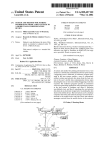
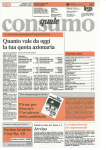

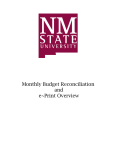

![mm [mm [1 um um [11115151116 |])|]1]](http://vs1.manualzilla.com/store/data/005839409_1-1dd2adaaab9a040f039445848c9c3135-150x150.png)
